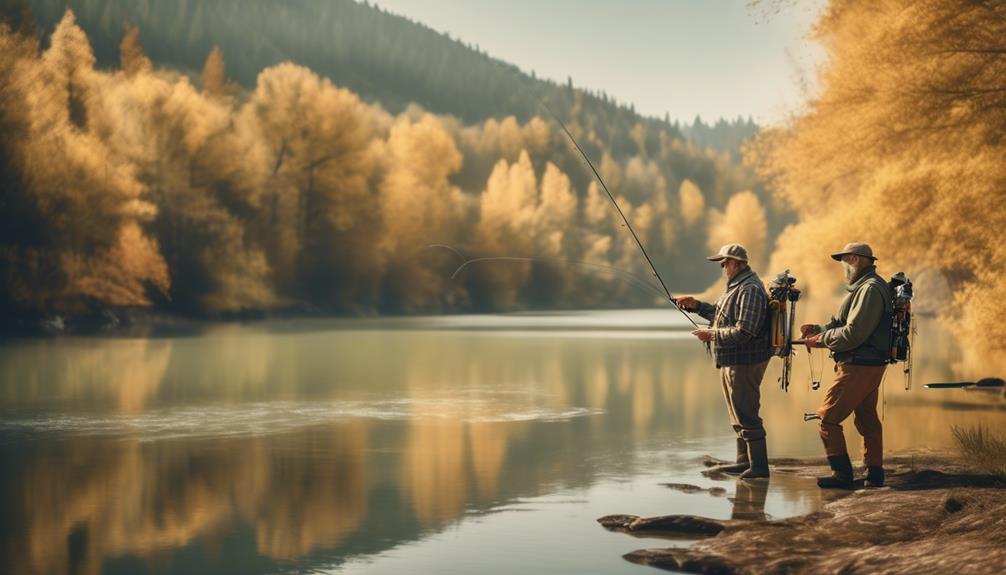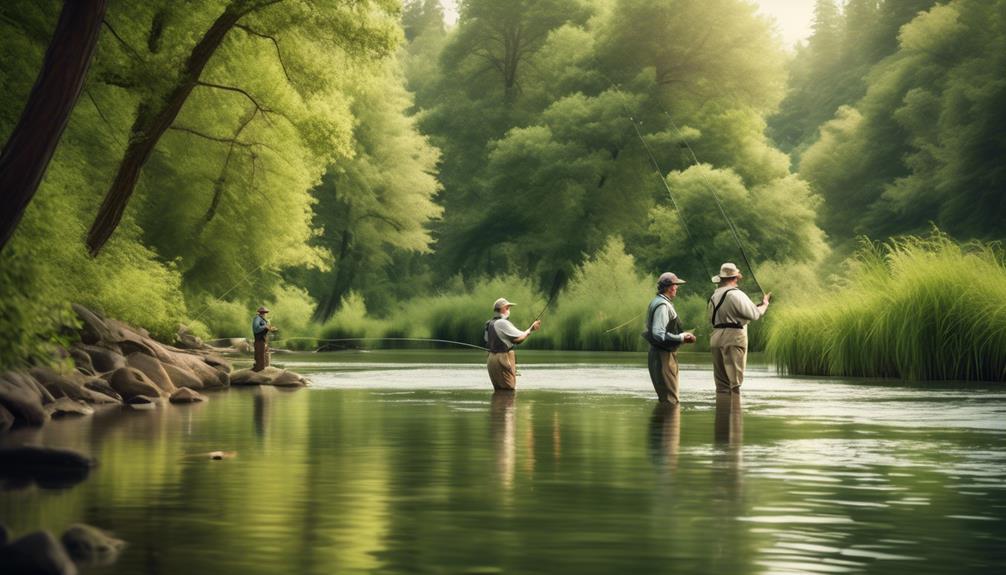When it comes to fishing, you may think that all methods are essentially the same, but when you compare fly fishing to regular fishing, you'll quickly realize that there are some significant differences that set them apart.
From the gear and casting techniques to the types of fish targeted and the environmental impact, each approach offers its own set of unique advantages and challenges.
These differences can make a world of a difference in your overall fishing experience, and understanding them could completely change the way you approach your next angling adventure.
Gear and Equipment
When fly fishing, it's essential to use specialized gear and equipment designed for casting lightweight artificial flies. Unlike regular fishing equipment, fly fishing gear includes a specific type of rod, reel, and line that are optimized for casting and presenting flies to fish.
Fly fishing rods are typically longer, lighter, and more flexible than regular fishing rods, allowing for delicate presentations of the fly. The reel for fly fishing is designed to store the fly line and provide smooth drag when fighting fish, while the line itself is specially weighted to match the casting capabilities of the rod. These specialized components work together to create a unique casting experience that's tailored to the art of fly fishing.
In contrast, regular fishing equipment is geared towards casting and retrieving lures or bait with the use of heavier lines and more rigid rods. The design of regular fishing rods and reels emphasizes the ability to cast heavier lures or bait over longer distances and to handle the fighting power of larger fish.
The fundamental difference lies in the casting technique and the type of bait used, with fly fishing focusing on the presentation of lightweight artificial flies that mimic natural insects.
Understanding the distinct gear and equipment used in fly fishing versus regular fishing is crucial for anglers looking to explore the nuances of each method. By using the appropriate gear for each style, you can fully immerse yourself in the unique experience that fly fishing offers.
Casting Techniques
To improve your fly fishing skills, mastering the precise casting techniques is essential for effectively presenting artificial flies to the fish. When it comes to distance casting, fly fishing and regular fishing differ significantly. With fly fishing, the weight of the line is what carries the lightweight fly to the target. To achieve distance, the key is in the timing and control of the casting stroke, allowing the line to roll out in a tight loop. In regular fishing, the weight of the lure or bait aids in casting the line, allowing for a different casting technique.
Accuracy casting is crucial in both types of fishing, but the methods differ. With fly fishing, accuracy casting is vital for placing the fly precisely where the fish are feeding. This requires delicate presentation, especially when using dry flies that float on the water's surface. In contrast, wet fly fishing involves casting the fly slightly upstream and letting it drift naturally in the current, making accuracy equally important.
When it comes to regular fishing, accuracy casting is also important, but the focus is on placing the bait or lure in a specific spot to attract the fish. The casting techniques in regular fishing often involve more forceful motions to propel the heavier bait/lure to the desired location.
Types of Fish Targeted
Different fish species are targeted when fly fishing compared to regular fishing. In freshwater environments, fly fishing often targets species like trout, bass, panfish, and grayling. These fish are known for their elusive nature and are often found in streams, rivers, and lakes. The technique of fly fishing allows anglers to present small, lightweight artificial flies to these freshwater species in a way that mimics the insects and other natural prey found in their environment.
On the other hand, regular fishing in freshwater environments may target a broader range of species, including those mentioned for fly fishing, as well as catfish, pike, and muskellunge. Regular fishing techniques involving bait or lures can be effective for catching these larger and more aggressive freshwater species.
When it comes to saltwater environments, fly fishing often targets species such as tarpon, bonefish, permit, and various types of saltwater salmon and trout. These fish are typically found in coastal areas, saltwater flats, and estuaries. The lightweight flies used in fly fishing are designed to imitate the movements of baitfish and crustaceans, which are common prey for saltwater species.
Regular fishing in saltwater environments, on the other hand, may target larger species such as tuna, marlin, and swordfish, using heavier tackle and bait to handle the size and power of these ocean-dwelling creatures.
Bait and Lures Used
Fly fishermen often rely on using lightweight artificial flies, while regular fishermen may use a variety of bait and lures to attract their target species. The choice of bait and lures differs significantly between fly fishing and regular fishing.
In fly fishing, the emphasis is on artificial flies, which are painstakingly crafted to resemble insects, small fish, or other natural prey. These artificial flies are designed to float, sink, or hover in the water to mimic the behavior of real insects or baitfish.
On the other hand, regular fishermen often use a mix of artificial lures and natural baits. Artificial lures can include spinners, spoons, plugs, or soft plastic baits, each designed to imitate the movement and appearance of prey. Natural baits such as worms, minnows, and insects are also commonly used in regular fishing.
The choice between artificial and natural baits and lures is one of the key distinctions between fly fishing and regular fishing. Fly fishing predominantly relies on artificial flies, whereas regular fishing offers a broader range of options, encompassing both artificial lures and natural baits.
Additionally, the method of presenting bait or lures also differs between fly and spin fishing. Fly fishing involves delicate presentations with the use of a fly rod, while spin fishing often involves casting and retrieving lures using a spinning rod and reel.
Understanding these differences can help you choose the most suitable approach for your fishing endeavors.
Fishing Locations
You can locate fly fishing in freshwater streams, rivers, and lakes, while regular fishing can be found in a wide range of freshwater and saltwater environments. Fly fishing predominantly takes place in freshwater, where anglers target species like trout, salmon, and bass. Freshwater fly fishing often involves wading in shallow streams or casting from the shoreline of lakes and rivers.
On the other hand, regular fishing isn't limited to freshwater; it extends to saltwater environments, including oceans, seas, and coastal areas. Regular fishing allows for a diverse range of locations, from freshwater lakes and rivers to saltwater bays and deep-sea fishing grounds.
When it comes to saltwater versus freshwater fishing, fly fishing is typically associated with freshwater locations, while regular fishing can take place in both saltwater and freshwater environments. Saltwater fishing offers anglers the opportunity to target species such as marlin, tuna, and snapper, which aren't typically pursued in freshwater settings.
In terms of shoreline versus boat fishing, fly fishing often occurs from the shoreline, with anglers wading into the water to cast their lines. Regular fishing, however, encompasses both shoreline and boat fishing. Anglers can choose to fish from the shore or venture out into deeper waters on boats, giving them access to a wider range of fishing opportunities and species.
Movement and Technique
To improve your success in fly fishing and regular fishing, mastering the movement and technique is essential. Whether you're casting a line for trout in a mountain stream or angling for bass in a calm lake, honing your skills is crucial for a successful fishing experience. Here are some key differences in movement and technique between fly fishing and regular fishing that you should consider:
- Line Control: In fly fishing, precise control of the line is crucial for successful casting. The angler uses the weight of the line to cast the lightweight fly accurately to the target. Regular fishing, on the other hand, involves more straightforward line control, with the emphasis on bait presentation and retrieval.
- Precision Casting: Fly fishing demands a high level of precision casting. The angler uses specialized casting techniques to present the fly delicately and accurately to the fish. In regular fishing, casting may involve a broader range of techniques depending on the fishing style and the type of bait being used.
- Standing Water Techniques: In regular fishing, standing water techniques are commonly used for targeting fish in lakes, ponds, and calm reservoirs. This may involve using floats, sinkers, or specialized rigs to present the bait effectively.
- Moving Water Techniques: Fly fishing often involves targeting fish in moving water, such as rivers and streams. This requires an understanding of how to position oneself in the current and present the fly in a natural manner to entice the fish.
Mastering these movement and technique differences is essential for achieving success in both fly fishing and regular fishing.
Cost and Accessibility

Mastering the movement and technique differences between fly fishing and regular fishing can also shed light on the distinctions in cost and accessibility between the two methods.
When it comes to accessibility, regular fishing often provides more options due to the abundance of lakes, rivers, and oceans. This means you can find regular fishing spots closer to home, reducing travel expenses and time commitment. In contrast, fly fishing often requires specific types of water bodies and may involve more travel and time. However, the tranquility of fly fishing in remote areas can be an appealing aspect for those seeking a peaceful fishing experience, despite the added travel expenses and time commitment.
In terms of cost, regular fishing generally requires a lower equipment investment compared to fly fishing. The basic gear for regular fishing, such as a rod, reel, and bait, is often more affordable and easily accessible. Additionally, obtaining a fishing license is usually straightforward and inexpensive.
On the other hand, fly fishing demands specialized equipment like a fly rod, reel, and various types of flies, which can be more costly. Furthermore, fly fishing in certain areas may necessitate a more expensive or harder-to-obtain fishing license due to conservation efforts or specific regulations.
Environmental Impact
When considering the environmental impact, it's essential to recognize the distinct effects that fly fishing and regular fishing have on aquatic ecosystems. Both fishing methods have an impact on the environment, but the extent and nature of these impacts differ significantly.
Here's how the environmental impact of fly fishing compares to regular fishing:
- Habitat Disturbance: With fly fishing, the casting of lightweight artificial flies causes minimal disturbance to the aquatic habitat compared to the heavy lures or baits used in regular fishing. This reduced habitat disturbance helps in preserving the natural ecosystem and the species within it.
- Bycatch and Selectivity: Fly fishing tends to be more selective, as anglers can target specific fish species more accurately. This selectivity reduces the unintentional capture of non-targeted species, promoting environmental conservation and sustainability practices.
- Use of Natural Resources: Regular fishing often involves the use of live bait, which can result in the overexploitation of natural resources such as worms, insects, or smaller fish. In contrast, fly fishing primarily uses artificial flies, reducing the reliance on live bait and contributing to sustainable fishing practices.
- Pollution and Waste: The use of lead sinkers and synthetic baits in regular fishing can lead to water pollution and environmental contamination. Fly fishing typically utilizes non-toxic alternatives, thereby minimizing pollution and promoting environmental conservation efforts.
Frequently Asked Questions
What Are the Specific Health and Fitness Benefits of Fly Fishing Versus Regular Fishing?
Fly fishing offers unique health benefits, including improved mental well-being and reduced stress levels. The physical demands of casting and wading provide fitness advantages, such as improved muscle strength and cardiovascular health, compared to regular fishing.
How Does the Experience of Fly Fishing Versus Regular Fishing Differ in Terms of the Level of Skill Required?
In fly fishing, the level of patience and precision is higher compared to regular fishing. Understanding water currents and mastering casting techniques are crucial. It requires more skill and finesse to be successful in fly fishing.
Are There Any Unique Conservation or Environmental Considerations When It Comes to Fly Fishing Versus Regular Fishing?
When fly fishing, consider conservation ethics and environmental impact. Different techniques and bait selection in fly fishing may impact the environment differently than regular fishing. Be mindful of these unique considerations for a sustainable fishing experience.
What Are the Differences in Terms of the Social and Community Aspects of Fly Fishing Versus Regular Fishing?
In terms of social bonding, fishing communities, environmental impact, and conservation efforts, fly fishing and regular fishing differ. Fly fishing often involves smaller, tighter-knit groups, while regular fishing can be more social and communal.
How Does the Overall Experience and Satisfaction of Catching a Fish Differ Between Fly Fishing and Regular Fishing?
When you compare fly fishing and regular fishing, the overall satisfaction of catching a fish differs due to the unique techniques and environmental impact. Fly fishing emphasizes precision and finesse, leading to a deeper connection with each catch.
Conclusion
So, whether you're a fly fishing enthusiast or a regular angler, it's clear that there are some distinct differences between the two.
From the gear and techniques used to the types of fish targeted and the environmental impact, each style of fishing offers its own unique experience.
Whether you prefer the peace and tranquility of fly fishing or the simplicity of regular fishing, there's something out there for everyone to enjoy.
Happy fishing!



